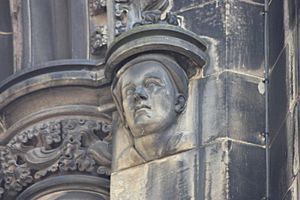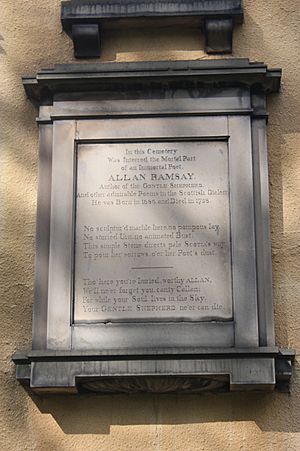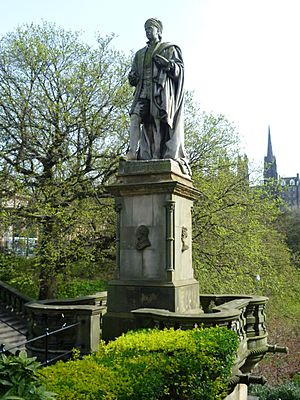Allan Ramsay (poet) facts for kids
Quick facts for kids
Allan Ramsay
|
|
|---|---|

Portrait painted in 1722
by William Aikman (1682–1731) Ramsay's friend, Sir John Clerk of Penicuik, owned Aikman's portrait of Ramsay, in imitation of whose verse he had written on the back of the canvas: Here painted on this canvas clout by Aikman's hand is Ramsay's snout |
|
| Born | 15 October 1684 Leadhills, Lanarkshire, Scotland |
| Died | 7 January 1758 (aged 71) |
| Occupation | poet |
| Nationality | Scottish |

Allan Ramsay (born October 15, 1686 – died January 7, 1758) was a famous Scottish poet. He was also a playwright, publisher, and librarian in Edinburgh during the early Scottish Enlightenment. This was a time when new ideas and learning were very popular.
Contents
Allan Ramsay's Early Life and Work
Allan Ramsay was born in Leadhills, Scotland. His father, John Ramsay, managed lead mines for Lord Hopetoun. His mother, Alice Bower, was from Derbyshire, England. Allan and his older brother Robert likely went to the local school in Crawfordjohn.
In 1701, Allan began training to be a wig-maker in Edinburgh. By 1709, he had finished his training. He married Christian Ross in 1712. A few years later, he opened his own wig-making shop on the High Street in Edinburgh. He became quite successful and comfortable. Allan and Christian had six children. Their oldest child, also named Allan Ramsay, became a famous portrait painter.
Becoming a Poet and Bookseller
Ramsay started writing poems after joining the Easy Club in 1712. He became the club's official poet in 1715. In the club, he used the pen names "Isaac Bickerstaff" and "Gawin Douglas." Choosing "Gawin Douglas" showed his pride in his family and his interest in old Scottish poetry.
By 1718, Ramsay was known for his poems, which he printed on single sheets of paper. Around this time, he also became a bookseller in the same place where he made wigs. In 1716, he published a version of "Christ's Kirk on the Green." He added his own verses to it and republished it in 1718. The next year, he printed a collection of Scots Songs.
These projects were very successful. In 1720, he decided to collect all his poems and publish them in a book in 1721. People bought subscriptions to the book, and he earned a lot of money. Four years later, he moved to a new shop in the Luckenbooths. There, he opened a circulating library, which allowed people to rent books. This was the first circulating library in Britain, starting in 1726.
Famous Works and Plays
Between 1721 and his move to Luckenbooths, Ramsay published more short poems. He also started two important collections: The Tea-Table Miscellany (1723–37) and The Ever Green (1724).
The Tea-Table Miscellany was a collection of popular Scottish and English songs. It included some of Ramsay's own songs, some by his friends, and old ballads. He named it to suggest it was perfect for enjoying during tea time.
In The Ever Green, Ramsay wanted to bring back interest in older Scottish literature. Most of the poems came from the Bannatyne manuscript, an important collection of old Scottish writings. He included his version of "Christ's Kirk" and a new poem called "The Vision."
While working on these collections, he wrote his famous play, The Gentle Shepherd, in 1725. This play was a pastoral drama, meaning it was set in the countryside and featured shepherds. It was incredibly popular, had many editions, and was performed in Edinburgh. Even today, its title is well-known in Scotland.
In 1726, he published a book of poems for the Royal Company of Archers. He wrote the words to their "Archer's March":
Let hills and dales rebound it,
Let hills and dales rebound it
In praise of Archery.
Used as a Game it pleases,
The mind to joy it raises,
And throws off all diseases
Of lazy luxury.
|
Now, now our care beguiling, |
Tis now the archers royal, |
Sound, sound the music, sound it, |
Another book of his poems came out in 1728. After this, Ramsay wrote less, though he did publish new editions of his earlier works. He corresponded with famous writers like John Gay and Alexander Pope.
Ramsay was a strong supporter of theatre. In 1736, he built a new theatre in Edinburgh. However, it faced strong opposition and had to close in 1737. In 1755, he retired from his shop and moved to a house on the side of the Castle Rock. This house is still known as Ramsay Lodge and was called "the goose-pie" by his friends because of its unusual octagonal shape.
Allan Ramsay is buried at Greyfriars Kirkyard in Edinburgh. His grave is not marked, but a monument was put up in his memory on the south wall of Greyfriars Kirk in the mid-1800s.
Memorials to Allan Ramsay
Many places honor Allan Ramsay's memory:
- In 1846, Ramsay was featured as one of sixteen Scottish poets and writers on the Scott Monument in Edinburgh.
- A statue of Ramsay was put up in 1850 in Edinburgh, at the corner of Princes Street Gardens and The Mound.
- There is a hotel in Carlops named after him. This hotel has hosted festivals celebrating Ramsay's birthday since 2016.
- A bust (a sculpture of his head and shoulders) of Ramsay is in the Hall of Heroes at the National Wallace Monument in Stirling.
- The Ramsay Obelisk, a tall, thin monument, was built in 1759 on the Penicuik Estate by his friend, Sir James Clerk.
Allan Ramsay's Family
Allan Ramsay's oldest daughter, Christian Ramsay, lived on New Street in Edinburgh. She was a kind person who also wrote poetry. She never married and lived with many cats. Even after being hit by a carriage at age 73, she lived to be 88 years old.
His oldest son, Allan Ramsay, was born in Edinburgh. He became a very important Scottish portrait painter. When he was twenty, he studied art in London. Later, in 1736, he traveled to Rome and Naples to learn from famous Italian painters.
Allan Ramsay's Legacy
Allan Ramsay is important in literary history for two main reasons. First, as a writer of pastoral works like The Gentle Shepherd, he helped bring a more natural style to writing in the 1700s. His focus on country life was a step towards the Romantic movement, which broke away from older, more formal styles.
Second, and most importantly, he was a key editor. He connected the great Scottish poets of the 1400s and 1500s with later poets like Robert Fergusson and Robert Burns. Ramsay helped bring back interest in Scottish vernacular literature (literature written in the local language). He directly inspired the genius of these later, more famous writers.
In his book The Ever Green, Ramsay argued against "foreign embroidery" in writing. He wanted writers to return to simple Scottish traditions. While he wasn't a strict scholar and sometimes changed old texts, his goal was to make old Scottish poetry enjoyable for people again. He helped spark a renewed interest in Scottish literature, similar to how Percy's Reliques did in England.
The Tea-Table Miscellany was reprinted in 1871. The Ever Green was reprinted in 1875. A collection of The Poems of Allan Ramsay was published in 1877. Many popular versions of his most famous work, The Gentle Shepherd, are still available. This play is set in Carlops and the nearby Newhall Estate.
See Also
 In Spanish: Allan Ramsay para niños
In Spanish: Allan Ramsay para niños



